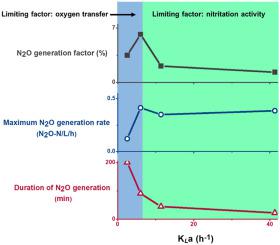Journal of Cleaner Production ( IF 9.7 ) Pub Date : 2021-01-25 , DOI: 10.1016/j.jclepro.2021.126104 Songkai Qiu , Zebing Li , Yuansheng Hu , Qingfeng Yang , Lujun Chen , Rui Liu , Xinmin Zhan

|
Volumetric oxygen transfer coefficient (KLa) is an important parameter affecting oxygen transfer and nitrogen conversion during biological wastewater management. However, how the generation of nitrous oxide (N2O) responds to the variation of KLa levels is unclear. In this study, N2O generation via the main pathway, which was confirmed to be nitritation, at different KLa levels was investigated in a partial nitritation-anammox (PN-A) reactor run as a sequencing batch reactor. The results showed that N2O generation in the PN-A process, which was described using the maximum N2O generation rate (MGR), the duration of N2O generation (DG), and the N2O generation factor, was affected by KLa levels and the limiting factors of the nitritation process, i.e., oxygen transfer and nitritation activity. DG always decreased with the increase of KLa, indicating that the process of N2O generation lasted for a shorter time at higher KLa. With the increase of KLa, MGRs remarkably increased when oxygen transfer was the limiting factor, while slightly reduced when nitritation activity became the limiting factor. As a result, with the increase of KLa levels, the N2O generation factor remarkably increased at lower KLa levels when oxygen transfer was the limiting factor, but significantly reduced at higher KLa levels when nitritation activity became the limiting factor. These results revealed how N2O generation via nitritation responded to different KLa levels and the limiting factors of the nitritation process. Based on these results, practical suggestions to mitigate the N2O generation in PN-A process operated in a batch mode were recommended.
中文翻译:

在部分硝化-氨氧化过程中,在不同的体积氧转移水平下,通过硝化产生N 2 O
体积氧传递系数(K L a)是影响生物废水管理过程中氧传递和氮转化的重要参数。然而,尚不清楚一氧化二氮(N 2 O)的产生如何响应K L a水平的变化。在这项研究中,N 2 ö代经由主通路,这被确认为亚硝化,在不同ķ大号一个水平是在部分亚硝化-厌氧氨氧化(PN-A)反应器运行的顺序间歇反应器的影响。结果表明,PN-A过程中会产生N 2 O,这是使用最大N 2来描述的O生成速率(MGR),N 2 O生成的持续时间(DG)和N 2 O生成因子受K L a水平和硝化过程的限制因素,即氧转移和硝化活性的影响。DG总是随着K L a的增加而降低,表明N 2 O的生成过程在较高的K L a下持续的时间较短。随着K L a的增加,当氧气转移是限制因素时,MGRs显着增加,而当硝化活性成为限制因素时,MGRs略有减少。结果,随着K L a含量的增加,当氧气转移成为限制因素时,N 2 O生成因子在较低的K L a含量时显着增加,但在较高的K L a含量时,亚硝化活性成为极限,N 2 O生成因子显着降低。因子。这些结果揭示了通过硝化作用产生的N 2 O如何对不同的K L a作出反应水平和硝化过程的限制因素。根据这些结果,提出了一些实用的建议,以减轻以批处理方式运行的PN-A工艺中N 2 O的产生。











































 京公网安备 11010802027423号
京公网安备 11010802027423号